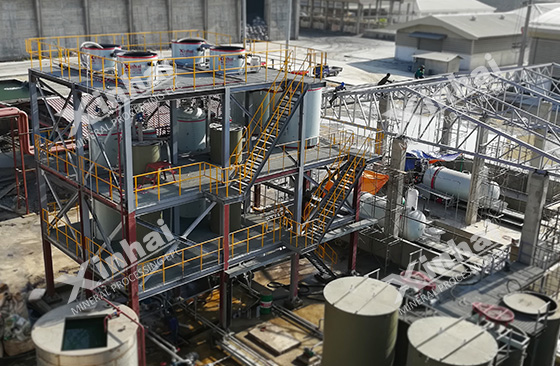
The main purpose of gold mine dressing is to extract gold from raw ore. By selecting the appropriate mineral processing method, the recovery rate of gold can be improved to maximize the extraction of gold from the ore. By selecting the appropriate mineral processing process, the gold can be effectively extracted to improve the economic benefit. The following will introduce two commonly used gold mine extraction technologies: CIP and CIL, they both involve the use of activated carbon adsorption gold, but they have certain differences, the following will understand the difference between the two and the way to improve the processing efficiency.

CIP process is to contact carbon pulp (containing fine carbon particles) with gold-containing pulp and use activated carbon to adsorb gold and other valuable metals. After oxidation pretreatment, the pulp enters the tank or column containing activated carbon, and the activated carbon adsorbs gold and forms gold-loaded activated carbon particles. Then, the slurry is separated by solid and liquid to separate the gold-loaded activated carbon from the slurry. Finally, gold is recovered from activated carbon through activated carbon regeneration and dissolution of gold.
CIL process is similar to CIP process, which also contacts carbon slurry with gold-containing slurry and uses activated carbon to absorb gold. However, unlike CIP, the CIL process sends the activated carbon into the exaching tank after adsorption. During the leaching process, a cyanide solution or other leaching is used to form a solution of gold. Then, gold was recovered from the solution by solid-liquid separation and precipitation, adsorption or electrolysis.

The technical difference between CIP and CIL of gold ore is mainly reflected in the leaching method, leaching agent, process flow and so on.
Leaching method: In CIP process, gold is absorbed on the activated carbon and then recovered from the activated carbon; and in CIL process, gold is directly adsorbed on the activated carbon to form a solution of gold.
Leaching agents: In the CIP and CIL processes, the commonly used leaching agents are mainly cyanide solution, but other chemical leaching agents can also be used. The selection of leagent depends on the ore characteristics and process requirements of gold.
Process flow: Although the CIP and CIL processes are similar in terms of activated carbon adsorption and gold recovery, there are some differences in the process flow. The CIL process requires the desorption of gold in the leaching tank, while the gold desorption in the CIP process is performed after solid-liquid separation.
Overall, both CIP and CIL processes utilize activated carbon for gold adsorption, but there are some differences in the gold recovery steps and processes. The choice of which process to use depends on the comprehensive consideration of multiple factors such as ore characteristics, process requirements and economic factors.

To improve the efficiency of CIP and CIL processes of gold ore, we can start from aspects such as slurry stirring, activated carbon selection, activated carbon regeneration, controlling leaching conditions, controlling solid-liquid separation, and process optimization:
1. Slurry stirring: Effective slurry stirring can ensure full contact between gold ore and activated carbon and improve the adsorption efficiency of gold. Properly adjust the stirring speed and time to evenly distribute the gold particles in the slurry and prevent agglomeration.
2. Activated carbon selection: Choose activated carbon with high adsorption performance and low activation rate to maximize the adsorption of gold and avoid excessive adsorption of other valuable metals. The selection of activated carbon should be optimized based on ore characteristics and process requirements.
3. Activated carbon regeneration: Properly regenerate the gold-adsorbed activated carbon to improve its adsorption capacity and utilization rate. Common activated carbon regeneration methods include pyrolysis and pickling.
4. Control the leaching conditions: Adjust parameters such as the concentration of the leaching agent, pH value, temperature, and stirring speed to optimize the gold desorption process. Proper leaching conditions can increase the dissolution rate and recovery rate of gold.
5. Control solid-liquid separation: Ensure an effective solid-liquid separation process to fully separate the gold-loaded activated carbon from the slurry. Use appropriate solid-liquid separation equipment, such as filter press, centrifuge or settling tank, etc.
6. Process optimization: Through laboratory and field tests, various aspects of the CIP and CIL processes are continuously studied and optimized to improve the extraction efficiency and recovery rate of gold. The optimal process conditions and operating parameters are selected taking into account the ore characteristics and economic factors. By comprehensively considering the above factors and optimizing and improving the system, the CIP and CIL process efficiency of gold ore can be improved and higher gold recovery rates can be achieved.

The above content is about gold mine CIP and CIL technology, which differentiate and improve efficiency. Different mineral processing technologies are suitable for different types of gold mines. Before selecting a suitable gold mineral processing technology, a mineral processing experiment analysis should be conducted to determine the ore characteristics. Xinhai Mining can provide you with customized gold ore beneficiation technology and a complete set of beneficiation equipment. Welcome to leave a message for consultation.
To find out more about our products and solutions, please fill out the form below and one of our experts will get back to you shortly.